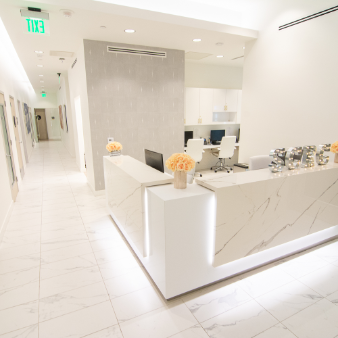
 Every patient arrives at the fertility clinic with their own history and their own unique needs, but the vast majority of infertility cases are caused by a handful of common problems. Tubal-factor infertility, or a problem with a woman’s fallopian tubes, is one of the most common.
Every patient arrives at the fertility clinic with their own history and their own unique needs, but the vast majority of infertility cases are caused by a handful of common problems. Tubal-factor infertility, or a problem with a woman’s fallopian tubes, is one of the most common.
Between 25 to 35 percent of female infertility is caused by tubal factors, according to The American Society for Reproductive Medicine (ASRM).
Scar tissue or adhesions from previous pelvic infections, surgery, endometriosis or hydrosalpinx can block eggs from traveling freely through the fallopian tubes, making it very difficult or impossible to get pregnant. If your doctor suspects that a blockage in your fallopian tubes could be a factor in your case, they may recommend that you undergo a test called a hysterosalpingogram, or HSG.
An HSG test is also sometimes used for women who have suffered repeated pregnancy loss: it may be able to show structural problems in the uterus or issues such as polyps or fibroids that could make it difficult to carry a baby to term.
What is a hysterosalpingogram?
An HSG is a special type of x-ray examination of the fallopian tubes and uterus. The entire test takes about 45 minutes.
During the procedure, a thin catheter is inserted through the cervix into the uterus, and a special radio-opaque contrast material dye is injected. The dye allows the shape of the uterus and fallopian tubes to be seen. The progress of the dye is followed through fluoroscopic x-ray to see how it moves through the reproductive system.
If there is no blockage, the dye should flow freely through the uterus and fallopian tubes. If the dye is stopped at any point, it may indicate that a tubal blockage is present. In that case, sometimes a laparoscopy or other surgical repair may be required. In many cases, the doctor may recommend moving straight to IVF. Because IVF bypasses the fallopian tubes completely, it is often very successful for women with tubal factor infertility.
How to prepare for the HSG test
If you need to have a hysterosalpingogram, there are a few things to consider before you go, and some simple ways to prepare which can make the experience easier for you.
- Consider going to a fertility specialist for your HSG test. A hysterosalpingogram can often be performed at a regular OB/GYN’s office or at radiology, but for patients trying to get to the root of infertility issues, it’s worth it to schedule an appointment with an infertility physician.
- Check whether insurance will cover your test. HSG tests are diagnostic, and may be covered by your insurance company, even if they do not offer coverage for fertility treatments.
- Know that the test is usually done between day 5-10 of your cycle. This is to ensure that you are not pregnant when the HSG is performed. If you have irregular cycles or are not sure whether you are ovulating, your doctor will perform a pregnancy test before the HSG.
- Make a list of any allergies you may have, especially to Iodine, Betadine, or Novocaine. Allergic reactions to the contrast dye are rare, but can occur. Be sure to tell your doctor if you have ever had an adverse reaction to any of the above. There are some alternate contrast materials that can sometimes be used in these cases, as well as other testing options.
- On the day of the test, take an anti-inflammatory pain medication such as Advil or Motrin an hour before the procedure. It is common to experience some mild to heavy cramping as the catheter is inserted, and pre-medicating with a painkiller can help minimize discomfort. You may want to take another dose later in the day, after the procedure.
- Ask your doctor whether you should take antibiotics before the procedure. In some cases, depending on diagnosis, your doctor may suggest a course of antibiotics before your HSG test to prevent the possibility of infection.
- Bring a pad with you. A small amount of spotting is normal after an HSG test, and there can also be leakage of the contrast dye. Wearing a pad for the rest of the day will help protect your clothing. You may need to wear a pad for a few days as the dye is slowly expelled from the uterus.
- Wear comfortable clothes. You may feel a bit tender after the procedure, so soft, non-restrictive clothing is best.
- Think about asking someone to drive you home. Most patients are able to drive themselves home after an HSG, but if you are not feeling well you might appreciate having someone there to drive.
- Consider taking the day off. While an HSG test is not a major procedure, going back to work afterwards may not be appealing. Some women find that cramping and spotting continues throughout the day. Feelings of dizziness or nausea are also possible. If you can, take a little time to recover and pamper yourself after the test.
What to expect after your HSG
After your HSG test, you should recover very quickly and be back to your normal activities by the next day. If any of the side effects become severe, you should contact your doctor right away. Heavy bleeding, severe pain, or fever are not normal side-effects and should be investigated immediately.
While undergoing an HSG test may not be a very pleasant experience, it can often provide the answers you are looking for. As an added bonus, a small number of women find that they become pregnant naturally soon after their HSG. This is probably that the flow of the dye dislodged a minor blockage such as an endometriosis lesion, freeing up the fallopian tube for normal operation.
No matter what, the test is worthwhile, even if it only serves to rule out a set of potential issues. A correct infertility diagnosis is so important for anyone who is struggling to conceive. Getting to the root cause of your fertility problems is the first step in your journey towards hopefully bringing home a healthy baby someday.
{{cta(‘8c9f7424-3e5a-436d-bf7d-e431640a6b1e’)}}




